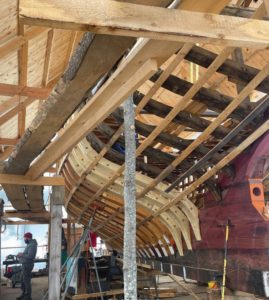PROVINCETOWN — For almost 70 years, the Schooner Hindu has carried tourists and locals alike through Provincetown Harbor, her afternoon voyages and sunset trips offering glimpses of a time when the town’s people and income depended on sailboats. There were once hundreds of sailing ships bringing codfish and whale oil to nearly 100 piers in the harbor, and the town’s diverse population was created and united by seafaring.

The Schooner Hindu is one of a very few wooden boats to survive from that era. Built as a pleasure craft in 1925 in Maine, she was converted to a cargo vessel in the Depression, requisitioned by the Navy in World War II, and has run trips through Provincetown Harbor since 1946. Generations of people have memories of their time aboard, and many residents, including this reporter, have served as crew.
For the last two summers, though, she has been absent from the waterfront, as her owner, Capt. Josh Rowan, has undertaken a complete rebuild and restoration of the vessel. The cutter Bloodhound, Rowan’s other boat, is running trips in her place, and the Independent caught up with Rowan in between sails to find out how the restoration of Hindu is progressing.
“We’re in the neighborhood of 50-percent complete,” said Rowan. “The hardest part of building a boat is the framing and the backbone, which is the centerline that goes from the stem, through the forefoot, the keel, all the way back to the keel stack, horn, and transom.” The meridian that runs from stem to stern, in other words, and the ribs that branch out from it, have been the focus of the last two winters, along with acquiring the wood necessary to make these vital parts.
“We’re using black locust for the frames, which is one of the strongest and most rot-resistant woods in the world,” said Rowan. Black locust is native to the Carolinas but was planted all over the East Coast in the maritime era, Rowan said, because the wood was so valued. “Now they’re planted all over the place and no one’s using them, so we’ve been able to literally knock on people’s doors in Maine and ask if they’ll sell us their tree,” he said.
Each frame, or pair of ribs, consists of about 20 precisely shaped pieces of black locust. The lay of the grain within each piece is critical for strength. At the most difficult curves on the central part of the boat, eight pieces of live oak were used, because the natural curve of live oak branches gives them strength under extreme pressure.
The ballast keel will be the same piece of iron as before, but the boat’s internal fasteners will be made of bronze this time, not iron.
“With an iron-fastened boat, eventually the wood gets iron sickness,” Rowan said. “The iron breaks down the lignin, which is the glue that holds the fibers of wood together. You’re eventually left with just the fibers — the wood will be hollow-sounding and look black — and visually it can look like something’s there, but structurally it can just pop.”

Like lead and copper, bronze has anti-microbial properties, so it actually helps prevent rot, Rowan said.
“The federal definition, when it comes to a rebuild of a vessel, is you honor the type of construction, the nuances of the build and design, and you can use better materials, but not worse,” said Rowan. “We made the fasteners removable and accessible, so the Coast Guard can inspect them. That doesn’t change the architecture.”
Rowan is also switching to a layered deck: wood planking above and below, with plywood and a waterproof membrane in between. Epoxies and membranes didn’t exist in 1925, but the advantages of a truly waterproof deck are too great to pass up.
“If you can keep the freshwater out, then all your electrical and mechanical systems last 10 times longer,” he said. “The way we’re doing this deck, the next time they’ll have to replace it is 50 years, and I won’t be around.” Rowan is 42.
Next winter’s work will include the hull planking — all cut from two Douglas fir trees from Oregon — and the first layers of the deck. Another winter will likely be required to get to a finished boat with a rough interior, which Rowan hopes to sail into town in June 2024. After a season doing trips on the harbor, Rowan and his father, Bill, will finish out the interior cabins that winter.
“And then, in 2025, everything has to be perfect,” said Rowan, “because that’s her 100th birthday.”
In addition to the shipbuilding, Rowan is working on one other project: resolving the ownership of float 10W, where the Hindu and now the Bloodhound are moored.
After owner and captain John Bennett died in 2002, Rowan said, the Provincetown Public Pier Corp. claimed ownership of the Hindu’s float.
Other members of the excursion fleet, such as Bay Lady II and the Dolphin Fleet of whale-watch boats, own their floats and pay a connection fee to the pier, Rowan said. Since Kevin “Foggy” Foley brought the Hindu back to Provincetown in 2006, the boat’s owners have paid both connection fees and rent. That rent allows for use of only one side of the float, while the town’s pump-out boats are moored on the other side.
Rowan said this arrangement has persisted but isn’t legal. The float and the seabed underneath are property under maritime law, and the town did not file any of the papers necessary to take them, Rowan contends.
He is hoping to bring the matter to the select board next month.
“Especially with the new rate structure at the pier, it’s not a viable thing,” said Rowan. “We can’t be paying more than everybody else.”
